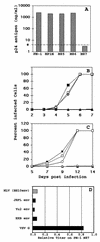Membrane-anchored peptide inhibits human immunodeficiency virus entry
- PMID: 11222732
- PMCID: PMC115933
- DOI: 10.1128/JVI.75.6.3038-3042.2001
Membrane-anchored peptide inhibits human immunodeficiency virus entry
Abstract
Peptides derived from the heptad repeats of human immunodeficiency virus (HIV) gp41 envelope glycoprotein, such as T20, can efficiently inhibit HIV type 1 (HIV-1) entry. In this study, replication of HIV-1 was inhibited more than 100-fold in a T-helper cell line transduced with a retrovirus vector expressing membrane-anchored T20 on the cell surface. Inhibition was independent of coreceptor usage.
Figures



References
-
- Buchacher A, Predl R, Strutzenberger K, Steinfellner W, Trkola A, Purtscher M, Gruber G, Tauer C, Steindl F, Jungbauer A, et al. Generation of human monoclonal antibodies against HIV-1 proteins; electrofusion and Epstein-Barr virus transformation for peripheral blood lymphocyte immortalization. AIDS Res Hum Retrovir. 1994;10:359–369. - PubMed
-
- Chan D C, Fass D, Berger J M, Kim P S. Core structure of gp41 from the HIV envelope glycoprotein. Cell. 1997;89:263–273. - PubMed
-
- Chun T-W, Engel D, Mizell S B, Hallahan C W, Fischette M, Park S, Davey R T, Dybul M, Kovacs J A, Metcalf J A, Mican J M, Berrey M M, Corey L, Lane H C, Fauci A S. Effect of interleukin-2 on the pool of latently infected, resting CD4+ T cells in HIV-1-infected patients receiving highly active anti-retroviral therapy. Nat Med. 1999;5:651–655. - PubMed
-
- Eckert D M, Malashkevich V N, Hong L H, Carr P A, Kim P S. Inhibiting HIV-1 entry: discovery of D-peptide inhibitors that target the gp41 coiled-coil pocket. Cell. 1999;99:103–115. - PubMed
Publication types
MeSH terms
Substances
LinkOut - more resources
Full Text Sources
Other Literature Sources

